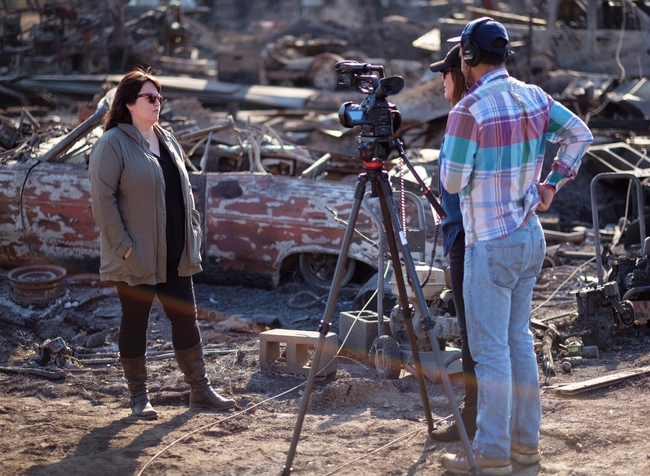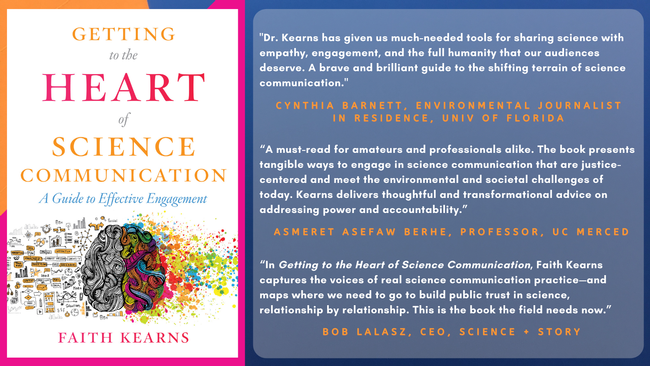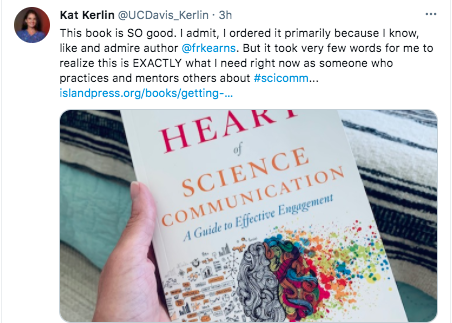Posts Tagged: communication
Communicating about climate crisis and other scientific issues requires more than facts
New book offers advice for discussing misconceptions and oversimplifications
Research can inform people to take appropriate action to solve problems, but effectively communicating is key. Faith Kearns, who works on emotional and contentious water-related issues such as climate change, drought and wildfire, has learned firsthand that the way scientists communicate can deeply affect people and communities.
Kearns, an academic coordinator for the California Institute for Water Resources at University of California Agriculture and Natural Resources, has written about what she has learned in 25 years of practice in a new book, Getting to the Heart of Science Communication: A Guide to Effective Engagement from Island Press. The book includes on-the-ground experiences of many science communicators, including those working in Cooperative Extension.
“The book offers an on-the-ground perspective on communicating emotional and contentious topics and is filled with concrete examples from practitioners, which is different from many science communication books written by journalists or researchers,” Kearns said. “It is centered around practical tools like relating, listening, working with conflict, and understanding trauma, all with an eye toward equity and justice.”
Among the many issues addressed in the book – ranging from food security to disasters – climate change is one of the biggest. Meteorologist and climate journalist Eric Holthaus notes in the foreword that giving people scientific facts isn't convincing many people that there is a climate crisis, much less solving the climate emergency. “This crisis is getting worse not because of a deficit of information, after all, but because of a deficit of action,” writes Holthaus.
Grist journalist Kate Yoder wrote, “For a long time, scientists have relied on a ‘deficit' model of communication. The idea is that if people are given enough facts and data about, say, climate change, then they'd accept the science— in a logical, rational way — and decide to take action. This idea isn't necessarily wrong, but it ignores the messiness of the world and the role that emotions play in guiding decisions.”
Kearns begins the book with a personal anecdote that changed the way she thought about science communication. After she and her colleagues gave a presentation on wildfire preparation to residents in Mendocino County, an emotional audience member explained to Kearns that he had labored to keep a recent wildfire from consuming his property and the way the researchers had presented their information without attention to the fact that a fire had just burned through the area had been re-traumatizing.
“Many communicators, including myself, have neglected other pieces of communicating that don't have to do with providing information,” Kearns said. “It's so important to know who you are in conversation with and what they've been through. Their history, communities, and personal experiences impact how they will receive scientific information. One of the most important skills you can have as a science communicator is to be able to listen well.”
Jonathan Wai reviewed Kearns' book in Science. He wrote: “The book offers a view from the front lines of science communication, profiling practitioners who explain their journeys and share stories of relationship building and community engagement. Framing herself as a scientist turned science communicator, Kearns describe her vision for the future of the field, one in which relational communication is fundamental.”
Kearns acknowledges in the preface that a single book cannot be all things to all people. “My hope is that I can fairly treat the argument that emotion, conflict, and power struggles are already present in science communication and engagement work and that ignoring them is counterproductive,” she wrote.
Getting to the Heart of Science Communication is written for science communicators and scientists working at research institutions, government agencies, consulting firms or nonprofit organizations. In addition, it will be of interest to those working with scientists including journalists and decision-makers. People interested in science will also find much to consider in this updated view of the science communication landscape.
The 280-page paperback is published by Island Press and can be ordered for $30 (use code HEART for a publisher discount) at https://islandpress.org/books/getting-heart-science-communication and wherever books are sold.
For more about science communication, see Kearns' blog at https://faithkearns.substack.com.
Trends we're watching in 2018: experts weigh in on water, GM, science communication and more
As we settle into 2018, it's natural to wonder what the New Year may bring. There have been dozens of "trend pieces" discussing what's in store. In this wrap, we consider possible 2018 trends in water, the GM debate, science communication, and food and nutrition.
Water
After one of the driest Decembers on record, many Californians continue to worry about water supply. I turned to UC ANR water expert Faith Kearns. Faith is a scientist and communicator at the California Institute for Water Resources, a UC ANR-based "think-tank" that integrates California's research, extension, and education programs to develop research-based solutions to water resource challenges. Faith writes about water issues for a number of publications, including UC's Confluence blog. She was recently
quoted in a Rolling Stone article about California's "climate emergency," penned by meteorologist/writer Eric Holthaus.Faith told me this:
"Water quantity and human use tend to be the dominant lenses that we use to talk about water in California, but they're not the only thing we need to be paying attention to. For example, water quality issues loom equally as large, and are of course related. But, even beyond that, there are also many non-use oriented ways that water impacts our lives - through recreation, aesthetics, and culture, just to name a few. A trend that I hope to see in 2018 is a broadening of the conversation on water, and an expansion of the kinds of knowledge that are brought to bear on water issues."
Editor's note: The quality of American drinking water continues to be a point of local and national concern; it will undoubtedly be an important topic in the 2018 midterm elections in certain congressional districts. Learn more about this vital public health and social justice issue by visiting the National Drinking Water Alliance website (NDWA). NDWA is funded by the W.K. Kellogg Foundation and coordinated by UC ANR's Nutrition Policy Institute.
The debate over genetically modified food: Entering a new era?
UC Davis associate professor and plant pathologist Neil McRoberts - who was recently named co-leader of UC ANR's Strategic Initiative in Sustainable Food Systems - shared his ideas about where we might be headed in terms of framing the GM discussion.
"...The GM debate is entering a new era with the growing use of gene editing - CRSPR-Cas9 - technology. Interestingly, this time around the ethics and socio-economics debate seems to be keeping pace with the science, as witnessed by the latest issue of the Journal of Responsible Innovation, which focuses on gene drive technologies and their uses. The special issue grew out of a workshop hosted at NCSU last year. The use of CRSPR has re-opened debates about how genetic modification should be regulated and labeled."
Editor's note: You can learn more about Neil's work here. He recently wrote a guest blog post for UC Food Observer about the importance of cash crops to smallholder farmers in Uganda and Malaysia. For more about the GM debate, read the text of Mark Lynas' speech to the Oxford Farming Conference, in which he tries to "map out the contours of a potential peace treaty" between GM proponents and the technology's opponents. h/t Nathanael Johnson.
Will 2018 usher in an era of more civil communication around science-based topics?
*It depends on us.
Across the board, our public discourse took a dive in 2017 ... and that's a shame. Here's to a New Year ... and resolving to do a better job at communicating with clarity, integrity and with less judgment. The advancement of science (and perhaps the preservation of our sanity) depend upon it.
I loved this piece by Tamar Haspel, which recently appeared in the Washington Post and specifically addresses science communication and agriculture/food issues. Shorter: If we want to persuade people, we have to be respectful. She writes:
“Rudeness can increase polarization and entrench disagreements even further. Nasty begets nasty; it's regression toward the mean ..."
As both a scientist and a communicator, UC ANR's Faith Kearns also informed my thinking on where the communications trend line ought to go for 2018, telling me that:
"One of the bigger challenges, and opportunities, facing the science communication community is how to really push ourselves to better incorporate more perspectives from the social sciences and humanities. This is particularly true on issues like food, agriculture, and the environment where so much of what is truly challenging is related to human behavior, decision-making, and psychology. It's not just a matter of using research on science communication to inform practice, but also of responsibly integrating different forms of knowledge into communication efforts."
Food and nutrition trends
There are an overwhelming number of food trend pieces out right now. The Hartman Group is a good account to follow to stay apprised of food trends throughout the year. Their Year in Review blog post is definitely worth a read. It identifies some trends from last year that will likely carry forward, including consumer demands for transparency, "conscious" consumerism, customized health and wellness, and the ways in which snacking is disrupting food culture. Bonus: you can access some of Hartman's industry reports via links included in the blog post.
For a largely culinary perspective of 2018 trends, check out the BBC's Good Food piece. Nationally-known dietitian Christy Brissette has written an interesting piece about nutrition trends (think algae, Stevia, chicory root fiber and eating for "Diabetes 3" - aka Alzheimer's).
And if you're having trouble keeping that New Year's resolution to exercise more, consider reading this piece, which reports on a study indicating that exercise alters our microbiome - which could improve our health and metabolism. Gretchen Reynolds for the New York Times.
Have a great week!
This article was first published in the UC Food Observer blog.







